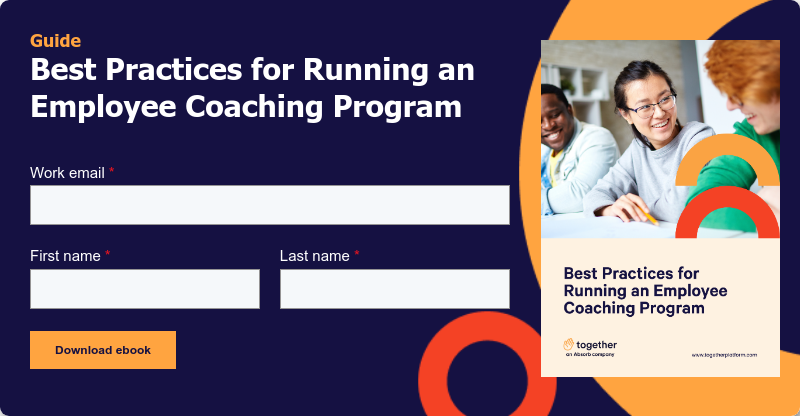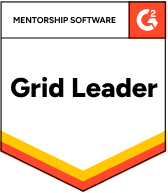“Great leaders aren’t born, they’re created” is a cliché for a reason: it’s true. Behind every great leader is a long history of other leaders that encouraged and coached them into what they are today.
Leadership succession planning is a challenge faced by many companies. Not only that, making sure those employees picked for leadership are properly trained and prepared is a whole other challenge.
The thing is: you already have experts in your midst. From middle managers up to the C-suite, you have access to a wealth of knowledge and experience to provide coaching for leaders—both new and experienced.
In this article, we’ll walk through how you can build a leadership development coaching program in your company including preparing your coaches, skill focuses, program design and promotion, and best practices.
Why corporate leadership coaching matters
Leadership development was identified as one of HR and L&D’s key priorities in 2025 for good reason. Corporate coaching is a powerful tool in your leadership development program, but what do we mean by “coaching”?
While the leadership coaching definition varies a little depending on an organization’s goals, essentially it’s a structured, one-on-one or small group process that aims to help an employee learn and practice new leadership skills, get direct feedback, and guide them to become stronger, more confident current or future leaders.
Coaching for leadership development is important because it helps instill core leadership skills such as emotional intelligence, communication, and decision-making skills. We’ll explore those core skills a little later on.
The difference between coaching and mentoring
While similar, there are key differences between leadership development coaching and mentorship programs that make each solution better suited for different situations.
Basically, the difference between coaching vs mentoring is:
- Coaching is a goal-oriented, specialized, short-term experience that focuses on building targeted skills, problem-solving, and performance improvement.
- Mentoring is a broader, long-term relationship that’s more flexible and focuses on overall career and personal growth.
Both approaches are valuable for leadership development, but professional leadership coaching is driven by the more experienced coach and empowers your coachee to achieve specific results.

What makes good leadership coaches? Coachees?
Before diving into designing and implementing your program, there are a few things you need to understand—especially when it comes to identifying who in your company will make good leadership coaches and coachees.
Good leadership coaches are:
- Active listeners: Great coaches make an effort to truly hear and understand their coachees, offering thoughtful and relevant guidance.
- Empathetic and supportive: Good leadership coaches create a safe, judgement-free zone where coaches are encouraged and motivated.
- Experienced and knowledgeable: Coaches should be leaders themselves and bring experience, their grasp of leadership principles, and strong coaching skills for leaders to give actionable advice.
- Adaptable: They recognize that every current and future leader is unique and can tailor their leader coaching techniques to the individual’s needs and goals.
- Accountability buddies: Great coaches balance support and guidance with accountability, making sure their coachees stay focused on their goals.
On the flip side, good candidates to receive leadership training and coaching are:
- Open and receptive: Your coachees come with a willingness to learn and consider new perspectives.
- Self-aware: They understand their strengths and areas they need to develop further, enabling them to undergo meaningful self-improvement.
- Committed to growth: Good coachees are eager to take action, put in the effort, and follow through on their coach’s guidance.
- Curious and reflective: They ask questions, explore different angles, and reflect on their progress.
- Resilient and flexible: A good coachee embraces challenges, takes feedback with grace, and stays flexible when plans need to be adjusted.
- High-potential: Employees already identified as having high leadership potential should already be on your list of ideal coachees.
Pairing employees that have these qualities makes for a more meaningful and impactful leadership development and coaching relationship.
💡Need help identifying high-potential employees to add to your coachee list? Use a 9 Box Talent Review.
Skills to focus on in leadership development coaching
According to the International Institute for Management Development, there are 8 core skills every leader needs to develop:
- Relationship building
- Agility and adaptability
- Innovation and creativity
- Employee motivation
- Decision-making
- Conflict management
- Negotiation
- Critical thinking
Many of your potential coachees may already have a good grasp of some of these skills, but both your coaches and coachees should be able to identify what skills they need more work on.
Designing and launching your leadership coaching program
Now that you understand what a leadership development coaching program is, let’s walk through how to design, launch, and maintain your program.
💡Organize your program using a coaching plan template.
Identifying leadership training and coaching goals
Creating a short list of SMART goals for your program builds the foundation and direction. Having these guidelines helps you focus all coaching leadership development activities for the highest impact.
To set these goals, start by:
- Identifying your organization’s needs: Look for current business challenges and review strategic objectives. (ex. Preparing new and future leaders, improving top-down communication, etc.)
- Engage stakeholders: Talk to those who would be involved in the program, from leadership, to potential coaches, to employees and future participants.
- Use SMART goal framework: Set goals that are Specific, Measurable, Achievable, Relevant, and Time-bound (SMART).
- Use data: Bring in past performance metrics, employee feedback, and industry benchmarks to help you create realistic targets.
- Define success: Decide what key performance indicators (KPIs) best align with your goals and how you’ll track them. (ex. New leader retention rates, higher employee satisfaction with company communication, etc.)
Leadership and coaching goals can look different for every company, but here are a few examples:
- Better communicate organizational change: Improve senior managers’ communication by 30% through targeted leadership coaching over the course of six months, as measured by employee satisfaction surveys.
- Build a leadership succession pipeline: Improve readiness scores of future leaders and retention of new leaders by 50% by implementing a four-month leadership coaching program that focuses on preparing them with core leadership skills.
- Improve strategic decision-making: Improve critical thinking and strategic decision-making skills by 20% and reduce reactive decision-making by 25% at all leadership levels through monthly leadership coaching and training sessions, as measured by scenario assessments and team feedback, respectively.
Planning the registration process
Now that you have a solid grasp of the goals your program is working towards, it’s time to plan how and when coaches and coachees will register. We recommend you plan for a three-week registration period.

Then build out the actual registration tool, such as a Google Form or specialized coaching and mentoring software that organizes participants and prepares them for matching.
A leadership development coaching program is intended for a smaller subset of employees, so build out your list of potential participants before finalizing your registration and promoting your program.
Shortlist your leadership coaches and coachees
Since a leadership development coaching program is more specialized than regular coaching, recruiting is a little more involved. Based on our list above of what makes a good leadership coach and coachee, you may have a few of your employees in mind already.
Here’s how to create your list of potential coaches:
- Ask for referrals: When speaking with stakeholders, ask them who they think would make good coaches or who would benefit from professional leadership coaching. Create a way for people to nominate candidates to help you start building a solid list.
- Review peer recognition: If your company does any kind of formal peer recognition, review those recipients to see if they’d make good leadership coaches or have leadership potential.
- Use talent review data: If you already have ways to assess employee potential, leverage that information to create a list of high potential employees to invite to your program as coachees.
- Vet potential coaches: Now that you have a list, review past performance evaluations, look at employee feedback, or reach out to their direct manager to make sure the candidate is suitable to coach.
Creating a promotion plan
Now it’s time to craft how you’re going to sell your program to your list of potential coaches and coachees.
Here are the main points you should hit when promoting your corporate leadership coaching program:
- Describe your program’s purpose
- Explain the value of their involvement as coach or coachee
- Outline the benefits of their participation (improved leadership skills, visibility, professional growth, etc.)
💡 Pro tip: Reach out to coaches first to gauge interest and plan how many coachees your program can handle.
Plan and schedule all your communications ahead of time to cover the three-week registration process and give everyone plenty of reminders.
Here is a sample communication plan to get you started:
- Send 2-3 pre-registration emails and 2-3 scheduled Slack/Teams messages introducing the program, benefits, and key dates to your shortlist of coaches and coachees.
- During registration, send reminder emails and Slack/Teams messages at regular intervals to keep your program top of mind.
- Use follow-up emails and personalized messages in Week 3 to catch any late registrants.
Matching leadership coaches with coachees
With everyone registered and excited about your program, it’s time to match participants. Since coaching in leadership development can be a little more complex, we highly recommend using automatic matching through a coaching platform to make sure skills, experience, and goals align.
A coaching and mentor matching app allows your participants to fill out detailed profiles which are then loaded into an algorithm that matches candidates based on your parameters, such as skill matching. This not only saves you time, it also ensures optimal matches.
Give participants a say in matching—While the algorithm does most of the heavy lifting, give your coaches and coachees a say. If either party isn’t sure about their match, they’re not going to be as invested in the partnership. Allow a grace period for rematching.
Measuring your leadership coaching program
In your coaching software, pull reports to monitor the success of your program. Here are a few KPIs to keep an eye on:
- Completed matchings: Review whether automatic matches are completed and progressing successfully.
- Number of active sessions: See whether coaches and coachees are meeting regularly according to their coaching plan.
- Feedback/satisfaction scores: Coaching software typically includes automatic session and program feedback surveys to help you measure participant satisfaction.
For more qualitative feedback, check in with your coaches and coachees regularly and ask questions like these:
- How has your coaching relationship been developing?
- Are you reaching the goals you set at the beginning of the program?
- Has the program met your expectations so far?
- What would make this program better in the future?
Get started strengthening your company’s leadership
Investing in a leadership development coaching program is a powerful step towards a strong future for your company. With thoughtful planning and the right tools, leadership training and coaching doesn’t need to be a heavy lift for program administrators.
Coaching and mentoring platforms, like Together, make it easier for you to build, monitor, scale, and sustain a leadership coaching program that supports both individual employee growth and responds to changes in your company’s needs—ensuring a stronger, more adaptable leadership pipeline for the future.
Learn how Together can help! Book a demo today.



.svg)







.svg)

